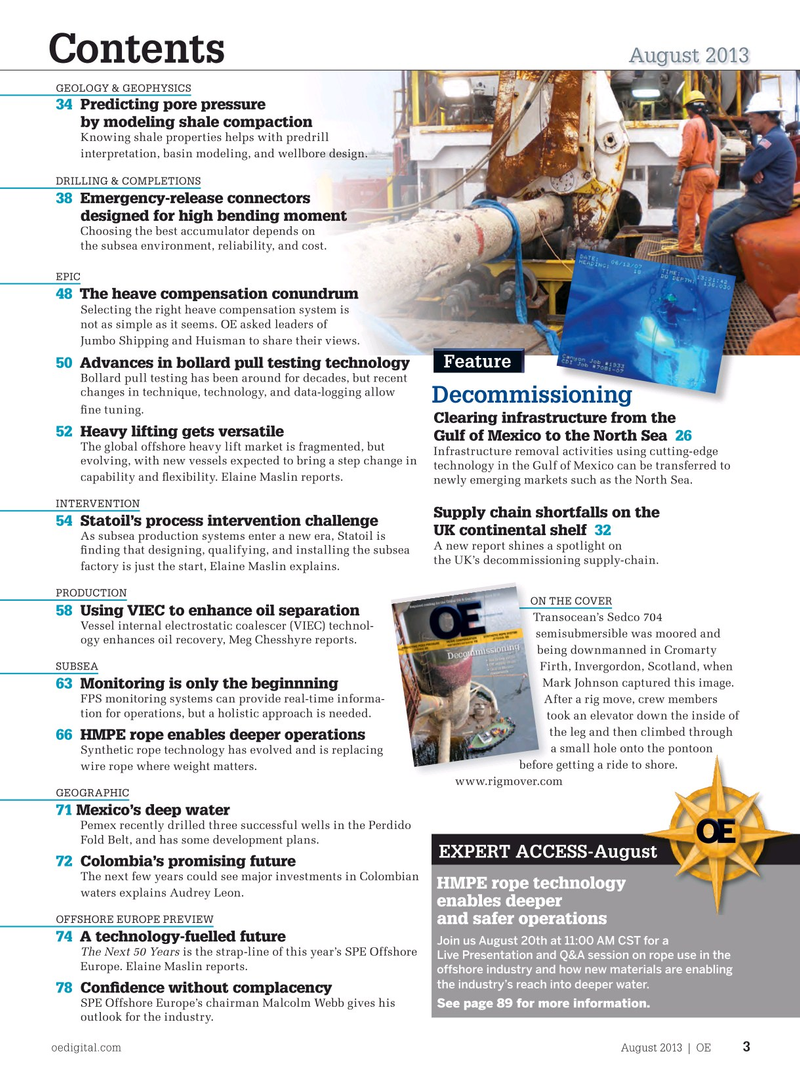
Page 1: of Offshore Engineer Magazine (Aug/Sep 2013)
Read this page in Pdf, Flash or Html5 edition of Aug/Sep 2013 Offshore Engineer Magazine
August 2013
Contents
GeOLOGY & GeOPhYSIcS 34 Predicting pore pressure by modeling shale compaction
Knowing shale properties helps with predrill interpretation, basin modeling, and wellbore design.
DrILLInG & cOMPLetIOnS 38 Emergency-release connectors designed for high bending moment
Choosing the best accumulator depends on the subsea environment, reliability, and cost.
ePIc 48 The heave compensation conundrum
Selecting the right heave compensation system is not as simple as it seems. OE asked leaders of
Jumbo Shipping and Huisman to share their views.
Feature 50 Advances in bollard pull testing technology
Bollard pull testing has been around for decades, but recent changes in technique, technology, and data-logging allow
Decommissioning fne tuning.
Clearing infrastructure from the 52 Heavy lifting gets versatile
Gulf of Mexico to the North Sea 26
The global offshore heavy lift market is fragmented, but
Infrastructure removal activities using cutting-edge evolving, with new vessels expected to bring a step change in technology in the Gulf of Mexico can be transferred to capability and fexibility. Elaine Maslin reports. newly emerging markets such as the North Sea.
InterventIOn
Supply chain shortfalls on the 54 Statoil’s process intervention challenge
UK continental shelf 32
As subsea production systems enter a new era, Statoil is
A new report shines a spotlight on fnding that designing, qualifying, and installing the subsea the UK’s decommissioning supply-chain.
factory is just the start, Elaine Maslin explains.
PrODuctIOn
On the cOver 58 Using VIEC to enhance oil separation
Transocean’s Sedco 704
Vessel internal electrostatic coalescer (VIEC) technol- semisubmersible was moored and ogy enhances oil recovery, Meg Chesshyre reports.
being downmanned in Cromarty
SuBSeA
Firth, Invergordon, Scotland, when
Mark Johnson captured this image. 63 Monitoring is only the beginnning
FPS monitoring systems can provide real-time informa- After a rig move, crew members tion for operations, but a holistic approach is needed.
took an elevator down the inside of the leg and then climbed through 66 HMPE rope enables deeper operations a small hole onto the pontoon
Synthetic rope technology has evolved and is replacing before getting a ride to shore. wire rope where weight matters.
www.rigmover.com
GeOGrAPhIc 71 Mexico’s deep water
Pemex recently drilled three successful wells in the Perdido
Fold Belt, and has some development plans.
EXPERT ACCESS-August 72 Colombia’s promising future
The next few years could see major investments in Colombian
HMPE rope technology waters explains Audrey Leon.
enables deeper
OFFShOre eurOPe PrevIeW and safer operations 74 A technology-fuelled future
Join us August 20th at 11:00 AM CST for a
The Next 50 Years is the strap-line of this year’s SPE Offshore
Live Presentation and Q&A session on rope use in the
Europe. Elaine Maslin reports.
offshore industry and how new materials are enabling the industry’s reach into deeper water.
78 Confdence without complacency
SPE Offshore Europe’s chairman Malcolm Webb gives his
See page 89 for more information.
outlook for the industry.
oedigital.com August 2013 | OE 3
OE_0813_toc.indd 3 7/23/13 8:45 AM

 2nd Cover
2nd Cover

 2
2